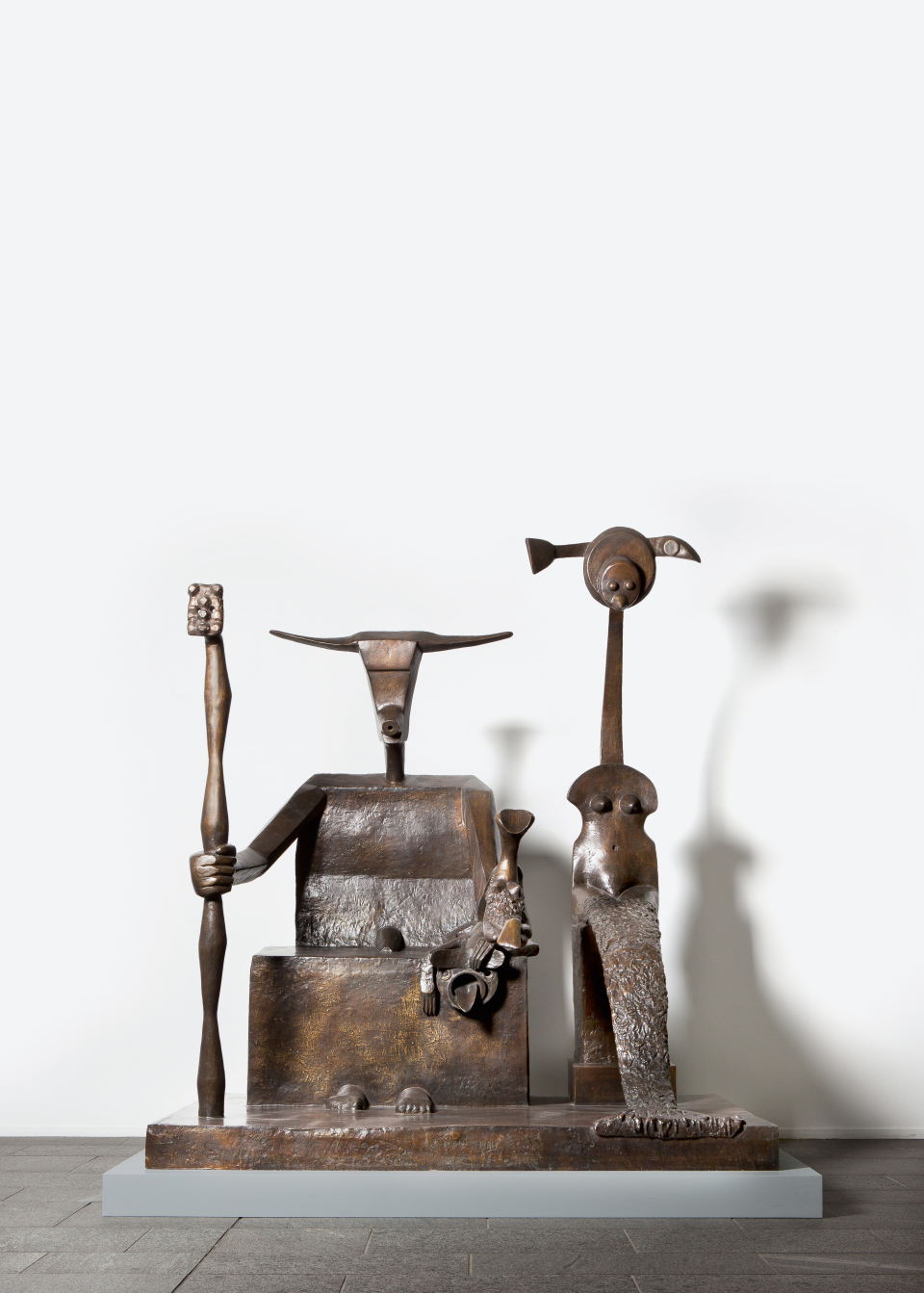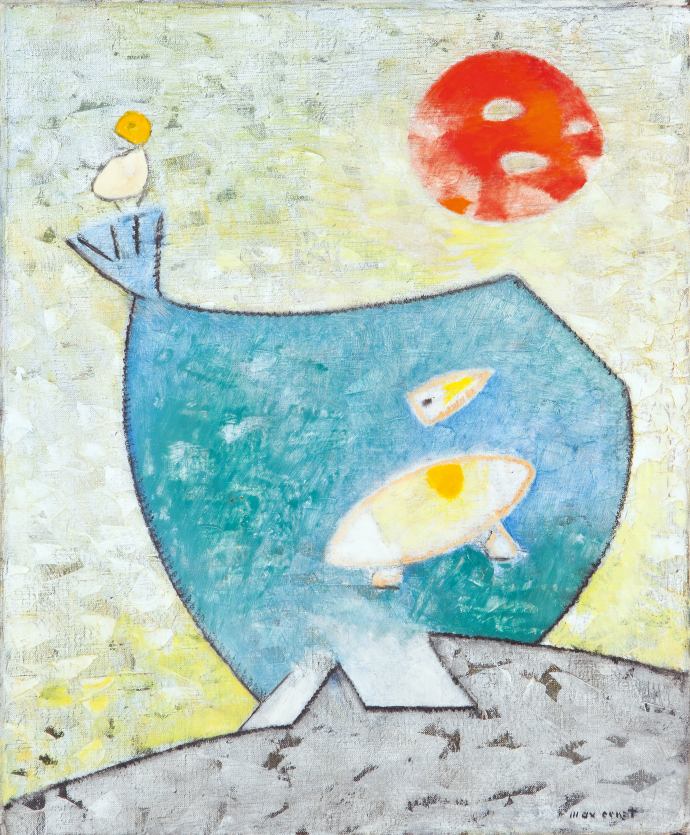
Hector-Building > Level 1 > Friends' Terrace
Karte

Intro
Max Ernst described the group of figures entitled »Capricorn« as “his family” and this monumental sculpture is in fact one of his major works. Here, the Surrealist artist draws on the sign of the zodiac Capricorn, which in Greek mythology was described as a cross between a goat and a fish. Here, however, Ernst divided it into a number of elements.
The block-like figure to the left, holding a scepter and mermaid in his hands, has goat-like features. In contrast, the slender female figure on the right, with her outstretched fin, is reminiscent of a fish. Both figures are chimera, part human and part animal, and are composed with a fine sense of irony.
Ernst produced the sculpture in 1948, initially in cement for the garden of his house in Sedona (Arizona), later in the form of bronze casts. As one of the most innovative collage artists of the 20th century, he incorporated casts of numerous found objects into his sculpture. The scepter, for example, is based on milk bottles, while its tip is a cast of an eggbox. As a major sculptural work, »Capricorn« embodies the sum of his artistic creation and represents a high point of his work in American exile.
Background
Max Ernst once described his monumental group of figures with the French title »Capricorne« as “my family”. The story of the creation of this major sculptural work by the Surrealist artist, who lived from 1941 onwards in exile in America, goes back to 1948. At this point, the artist and his wife, the painter Dorothea Tanning (1910–2012), had just moved from New York to the solitude of Sedona in the desert state of Arizona. Ernst created the first version of Capricorne for the garden of their house using pumice stone, concrete, recycled scrap metal and casts of everyday objects.
Beginning in 1964, a total of twelve bronze casts were made from a slightly altered plaster cast of this original object, which stood sentinel over the couple’s home, including the ensemble intended for the Kunsthalle Mannheim, which was cast in 1979. The central position is occupied by Capricornus. In Greek mythology, he is described as a hybrid creature, part goat and part fish, which Zeus set in the starry firmament as one of the signs of the zodiac. Firmly holding a sceptre of sorts in his right hand, Ernst’s hybrid creature consists of a human abdomen with a horned animal’s head and resembles an ancient tribal ruler.
Like the blocky figure of the archaic ruler, the two creatures grouped around his left lower arm are also surreal combinations of human and animal. In the composition of her body, the little mermaid sitting in the palm of the hand of Capricornus corresponds largely to the second main figure of the sculpture. This seated creature has exposed her upper body, which is shaped like a violin, and possesses a fish tail instead of legs. Two round discs resting on an elongated neck form the head of the female figure with only sketchily executed facial features.
Immediately behind the head of the seated figure is an equally cryptic depiction of a fish. Ernst played humorously with the traditional story and the laws of nature, not only in this motif of the aquatic creature, which seems to be swimming quite naturally through this, for a creature of the sea, hostile element. Stacked casts of milk bottles and an egg box, for example, form Capricornus’ sceptre. The artist thus makes of the dignified symbol of supremacy a symbol of power of a very different kind, which – like the sculpture as whole – also reflects Ernst’s fascination with the culture of the Native Americans.
Although the group of figures offers plenty of room for speculation, ultimately there is no escaping the statement made by the artist himself: his own family – Ernst himself, Dorothea Tanning and the couple’s two dogs – and the time they spent together under the southern sun of Arizona seem here to be condensed with wit and irony into the sculptural collage.
Transkription
Aren’t they just like a royal couple, those two sitting on a low pedestal? The slender queen looms with her fish tail and hat, her body similar to a string instrument. The king, on the other hand, looks massive and imperturbable, horned like a bull, holding a scepter in one hand and a third figure in the other.
Having fled the terrors of Nazi rule in 1941 for the US, Max Ernst built himself a house in the Arizona mountains. Around this time, he created the sculpture we are looking at. His fourth wife, American artist Dorothea Tanning, would call it the „princely guardians of the house“.
And it was Tanning who chose the final name: „Capricorne“for the respective sign of the zodiac. In Greek mythology, this sign is described as a hybrid between a ram and a fish, which is why Max Ernst has divided his bronze sculpture into two main figures, as becomes apparent by the king’s horns and the queen’s fish tail.
According to the legend, Capricorne was the child of Aigipan, i.e. Pan the Goat-Faced, and a nymph called Aix. It would be obvious to think that the ruler pair before us represent exactly those two, Aix and Aigipan. But when Max Ernst was asked about this matter, he answered: „That – is an image of my family.“
This image is composed of several parts which Ernst initially molded in cement. Just examine the tip of the scepter: it is surprisingly reminiscent of an egg carton, isn’t it? From 1964 onwards, 12 bronze castings of this ensemble were produced, among them the 1979 version in front of us.
On loan from the State of Baden-Württemberg since 1980
Kunsthalle Mannheim / Cem Yücetas
)
